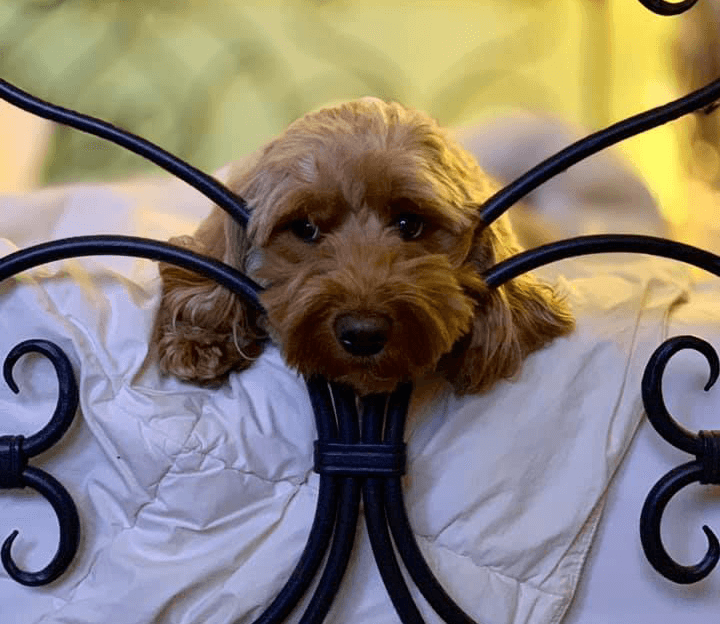Puppy Problems – Part III – Puppy Separation Anxiety

In part three of our common puppy problem series, we’re discussing puppy separation anxiety. Keep reading to learn how you can help your pup cope.
Is your puppy excessively whining or drooling when you leave the home? Barking for minutes, even hours?
Separation anxiety in dogs, however common, can be stressful for both pet parents and their dogs. If you live in an urban environment like a condo or apartment high rise, it can put strain on relationships with your neighbors, too. Thankfully, there are some easy ways to train your puppy to deal with the transition of you leaving.
What is Puppy Separation Anxiety?
New puppies, duringthe period when they are adapting to their new home, may experience some unwanted behaviors. As they acclimate themselves to your home and to you, they will likely become attached to one or more members of the household. Then, when you begin to adopt a routine, you may notice that when you leave your puppy alone for a short period of time, they become extremely anxious.
Not sure if your puppy is experiencing separation anxiety? Read on to learn more about the signs and symptoms and explore solutions like puppy play sessions to start socializing your puppy early.
Signs of Puppy Separation Anxiety
Here are some signs your dog may be suffering from separation anxiety:
- Excessive drooling
- Continued barking or whining
- Unwanted chewing (furniture, baseboards, etc.)
- Scratching of walls and doors
- Self-harm from trying to escape their crate or gated rooms
Whether your puppy is experiencing one or more of these signs, there are some preventative things you can do to help your puppy feel calmer.
What You Can Do to Improve Separation Anxiety
Here are some tried and true tactics you can implement to ease your puppy’s separation anxiety:
Start Crate Training Early
Crate training is an ideal way to put your puppy in a safe place that assists in relieving some of the symptoms of separation anxiety. Why? Because if trained properly, your dog will know their crate is their safe place.
As a reminder, you should never place your dog in their crate as a disciplinary measure. If they fear the space, they will never want to enter, and it will induce even more anxiety. Also, you should never crate dogs under six months old for more than a few hours. Once you trust your pup not to be destructive around the house, you can let them out when you leave the home for brief periods of time.
To motivate your dog into using the crate regularly, place treats or food in their crate. Then you can graduate to feeding them full meals in their crate. While they are eating, you can close the door for a few minutes and see how they react. Slowly increase the time they spend in the crate. If your puppy starts to whine or bark, pull back and reduce time in the crate.
For more information on how to crate train your dog, visit our guide on welcoming your new dog home.
Create and Stick to Your Schedule
Like children, puppies need schedules they (and you) can rely on. A routine gives them an idea of when to eat, when to go to the bathroom, when to play and when you are expected to leave.
Of course, a puppy’s schedule varies from that of an adult dog. Puppies need to use the bathroom far more often. So, in these early months, it’s crucial that you are at home often,so you are available to let your dog out according to the schedule you have set.
Make Coming and Going Uneventful
Leaving your home shouldn’t be a big deal, so don’t act like it. No long “goodbyes” or extra pets for your pup are allowed. In fact, it could increase your dog’s anxiety. Calmly walk your dog to their crate and close the door behind them.
Practice with short absences and increase them over time. For example, leave your pup alone when step out to get the mail. Then maybe for a trip to the gas station, a short shopping spree at the store, lunch hour, etc. This is especially useful for work at home dog parents, who leave less frequently, potentially increasing the likelihood and severity of separation anxiety when they do leave the home.
Consider Puppy Daycare
Puppy daycare is a wonderful service offered by a variety of organizations, including K-9 University Chicago. Puppies need special attention in their first years. Puppy free play and daycare are two options we offer to keep your pup active and social. In addition to receiving much needed play and training, you’ll avoid all the perils of separation anxiety.
Make Sure You Have Time for a Dog
This should go without saying, but so much of your puppy’s anxiety could be improved by lots of exercise, attention, and routine. If you are often not at home, reconsider getting a puppy. If you already have a puppy and are struggling, try some of the above tactics to reduce your dog’s separation anxiety.
Summary – Training Your Puppy to Cope
In summary, training for puppy separation anxiety should be done as a preventative measure for all dogs. We advise not waiting for your new pup to exhibit symptoms. All early training should focus on mitigating your dog’s stress – from crate training to establishing a routine. Your behavior matters too. Not making a big deal out of leaving your home, being present, and sticking to your routine will influence your dog’s behavior.
For more guidance, explore our puppy training classes.
Want more insights into common puppy problems? Read Part I and Part II of our series.


